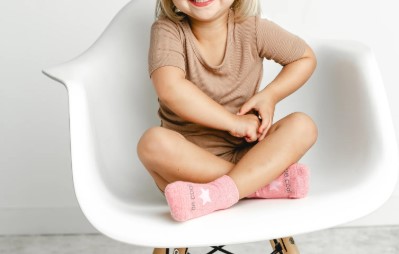
What makes a toddler grip a sock “the best” depends on where and how your child moves. Homes with hardwood or tile need dense, full‑foot traction. Early walkers benefit from thin, flexible soles that let toes spread and feel the floor. Daycare and soft‑play centers value stay‑on cuffs and easy‑wash fabrics. Winter calls for thicker knits; sweaty feet do better with bamboo or quick‑dry blends.
How we built this short list: we started from what matters most for safety and comfort—traction pattern & coverage, fit security, fabric breathability, cuff comfort, and care durability. Then we mapped picks to real‑life scenarios (walking practice, hardwood, daycare, winter, wide feet, inside‑shoe thinness). We avoid inflated star ratings and don’t make medical claims; instead, we summarize common parent feedback themes and check the product specs against the use case.
Best Picks
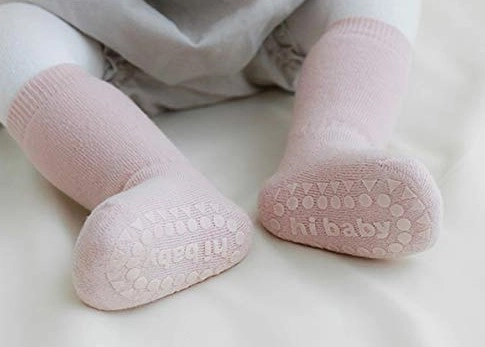
1) Max Hosiery Toddler Grip Socks — Best Overall
Best for: Everyday traction on mixed surfaces
Why we like it:
- Full‑foot silicone pattern delivers a reliable grip on wood and tile
- Cotton‑rich knit with soft seam for all‑day comfort
- Heel tab + gentle cuff help prevent slip‑offs
- Good color options for easy pairing
Things to consider: Choose snug sizing; oversized fits reduce grip contact.
Sizes/Materials: 6–12M, 12–24M, 2–4T; ~80% cotton / 18% poly / 2% spandex
2) Full‑Foot Max‑Grip Ankle Socks — Best for Hardwood & Tile
Best for: Homes with slick floors
Why we like it:
- Dense, heel‑to‑toe silicone with larger pads at heel/forefoot
- Medium thickness for cushion without bulk
- Low‑profile seam reduces toe rub on hard surfaces
Things to consider: Slightly warmer than thin practice socks.
Sizes/Materials: 12–24M, 2–4T; cotton‑rich + spandex
3) First‑Steps Thin Grippy Socks — Best for Walking (Early Steps)
Best for: Early walkers needing ground feel
Why we like it:
- Thin, flexible knit supports natural toe splay
- Micro‑dot pattern keeps traction without feeling bumpy
- Gentle cuff avoids marks on chubby ankles
Things to consider: Not for very cold floors—layer if needed.
Sizes/Materials: 6–12M, 12–24M; cotton/bamboo blend + spandex
4) Everyday Non‑Slip 6‑Pack — Best Budget Multipack
Best for: Daycare backups and frequent changes
Why we like it:
- Solid baseline traction with consistent dot layout
- Great cost per pair; easy to replace when outgrown
- Color variety simplifies sorting and matching
Things to consider: Fabric may pill sooner than premium picks.
Sizes/Materials: 12–24M, 2–4T; cotton/poly/spandex
5) Cool‑Dry Bamboo Grips — Best for Sweaty Feet
Best for: Warm climates and active toddlers
Why we like it:
- Bamboo/viscose blend wicks moisture to reduce clamminess
- Vent knit zones on the instep add airflow
- Evenly spaced micro‑grips feel smooth underfoot
Things to consider: Air‑dry to preserve bamboo softness.
Sizes/Materials: 12–24M, 2–4T; bamboo‑rich + spandex
6) Cozy Pile‑Knit Grips — Best for Winter & Cozy
Best for: Cold floors and nap time
Why we like it:
- Thicker pile knit adds warmth and cushion
- Large‑area heel/forefoot pads for traction on socks‑as‑slippers days
- Plush cuff is comfortable over pajamas
Things to consider: Too thick for tight shoes; use indoors.
Sizes/Materials: 12–24M, 2–4T; cotton/poly blend
7) Wide‑Fit Flex Grips — Best for Wide Feet / High Instep
Best for: Toddlers with wide forefoot or high arches
Why we like it:
- High‑stretch rib and deeper heel pocket reduce squeeze
- Broad grip layout matches wider toe box
- Soft seam construction minimizes toe pressure
Things to consider: Size down if between sizes.
Sizes/Materials: 12–24M, 2–4T; cotton/spandex (extra stretch)
8) Daycare‑Ready Stay‑On Grips — Best for Daycare & Soft‑Play
Best for: Classrooms and indoor play centers
Why we like it:
- Secure cuff + heel tab resists pull‑off during group play
- Name‑label panel for marking pairs
- Durable grips withstand frequent washing
Things to consider: Confirm your center’s sock policy: some require specific grip socks.
Sizes/Materials: 12–24M, 2–4T; cotton/poly/spandex
9) Thin‑Inside‑Shoe Grips — Best Thin Inside Shoes
Best for: Wearing inside roomy sneakers or pram shoes
Why we like it:
- Ultra‑thin knit reduces bunching inside shoes
- Minimalist forefoot dots for light traction during indoor play
- Smooth cuff slides easily under pant hems
Things to consider: Not ideal for slick tile when barefoot—use a fuller‑grip pair for that.
Sizes/Materials: 12–24M, 2–4T; cotton/nylon/spandex
10) Organic Cotton Essentials — Best Organic/Cotton‑Rich
Best for: Sensitive skin and eco‑leaning families
Why we like it:
- Classic ankle length for year‑round wear
- Things to consider: Organic fibers can feel stiffer until a few washes.
- Sizes/Materials: 6–12M, 12–24M, 2–4T; organic cotton + spandex
How to Choose: Buying Guide
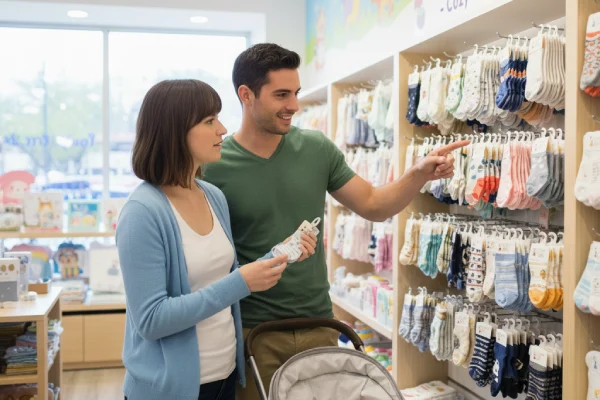
Grip pattern & coverage
On slick floors, coverage beats size: full‑foot, dense patterns provide more consistent traction than sparse dots. For wood and tile, look for heel‑to‑toe or full‑foot layouts; for early walking, a lighter forefoot‑focused micro‑dot can keep flexibility high while maintaining grip.
Materials & breathability
Cotton and bamboo (viscose from bamboo) feel soft and breathe well; a small amount of spandex helps the sock stay put. For warmer climates or sweaty feet, bamboo‑rich or quick‑dry blends are ideal. For winter, a thicker cotton/poly pile knit traps warmth—but keep an eye on bulk if you plan to wear them inside shoes.
Fit & cuffs
Snug > big. Oversized socks twist, and grips lose contact with the floor. Choose a gentle, non‑binding cuff that keeps socks up without leaving deep marks. Heel tabs and deeper heels help resist slip‑offs during play.
Use case
- Indoor early walking: thin, flexible socks (or barefoot) support natural foot motion.
- Hardwood/tile homes: prioritize dense, full‑foot traction.
- Daycare/soft‑play: pick stay‑on cuffs and durable grips; label your pairs.
- Shoes: inside snug shoes, use plain thin socks—grip textures can bunch and cause hot spots.
- Winter: thicker pairs add warmth, but switch to thinner socks for shoe time.
Price vs value
Toddlers outgrow socks fast, and grips wear with washing. A quality daily pair plus a budget multi‑pack for daycare is a smart mix. Replace when grips flatten, cuffs loosen, or heel holes appear.
Sizing: Get the Snug (Not Tight) Fit
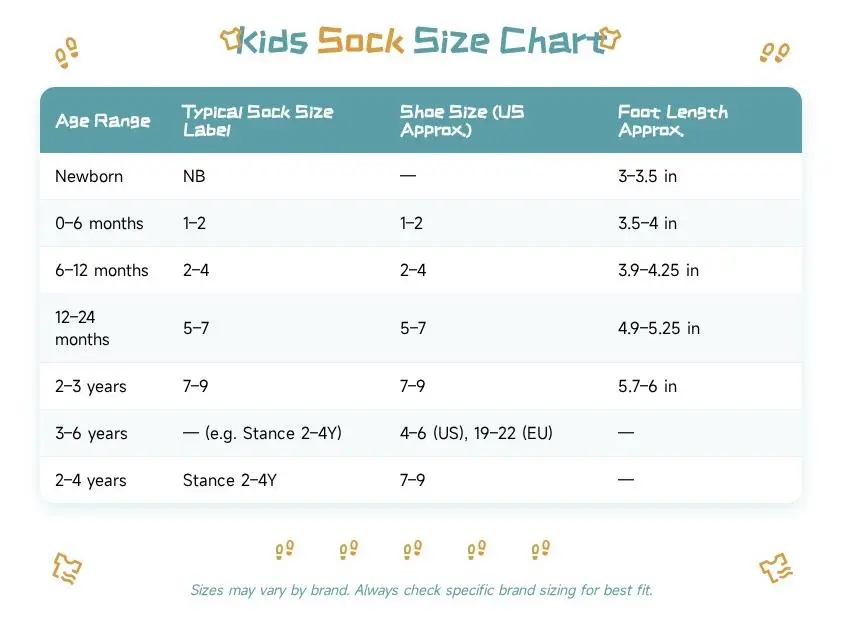
Step 1 — Measure foot length. Stand your child on a paper, mark the heel and the longest toe, and measure in cm or inches.
Step 2 — Match the chart. Use the brand’s chart to convert foot length to size bands (e.g., 6–12M / 12–24M / 2–4T).
Step 3 — Try‑on check (3 points).
- Heel lock: heel sits fully in the pocket;
- Toe room: a little wiggle room, no curling seam;
- Cuff check: no deep indentation after 10–15 minutes.
Borderline tip: If your child sits between sizes, choose the smaller for indoor grip socks so the pattern stays flush to the floor. (For plain socks inside shoes, sizing can be more forgiving.)
Age ≠ size. Two toddlers of the same age can have very different feet—always go by foot length and the brand’s chart. For newborn/infant size logic and sock types, see our full explainer: The Complete Guide to Infant Sock Types.
Safety & Labels (US Basics)
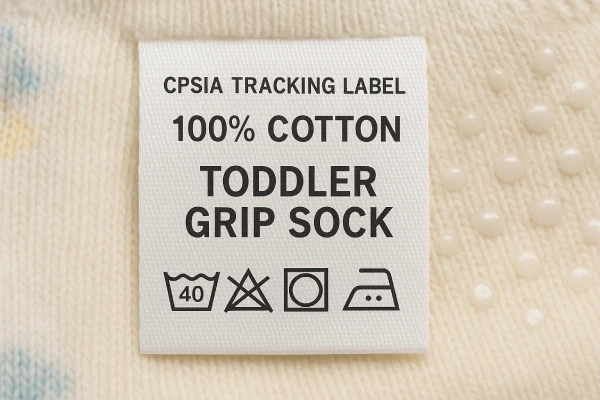
This is a plain‑English overview for parents—not legal advice.
- CPSIA (children’s products). Children’s textile products must meet CPSIA rules, including lead limits (generally 100 ppm in accessible parts) and third‑party testing with a Children’s Product Certificate (CPC) for regulated attributes. Check brands for traceability info on labels/packaging. U.S. Consumer Product Safety Commission+1
- Flammability (16 CFR 1610). Most everyday clothing textiles must pass the Standard for the Flammability of Clothing Textiles. Children’s sleepwear has stricter rules (different parts of CFR), but regular socks still fall under general clothing flammability. eCFR
- Labels you should see (FTC). Fiber content (by %), country of origin, and the manufacturer/importer identity are required under the Textile Fiber Products Identification Act (16 CFR 303). Regular care instructions must be provided per the Care Labeling Rule (16 CFR 423).
Socks vs Barefoot vs Slippers vs Shoes
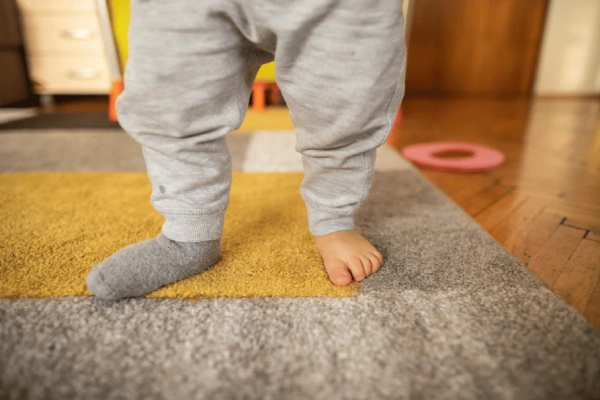
Indoors, many pediatric sources support barefoot or flexible socks for developing balance and foot strength; once toddlers start walking outdoors, shoes are needed mainly for protection. Grip socks are a helpful indoor middle ground—more traction than plain socks, more natural feel than shoes.
- Indoors (learning to walk): barefoot or thin-grip socks allow toes to feel the floor.
- Outdoors: shoes protect from heat/cold/rough surfaces.
- Inside shoes: prefer plain thin socks; textured grips can bunch and rub.
- Slippers: cozy, but many have less traction than purpose‑built grip socks.
FAQs
Do toddlers need non‑slip socks for hardwood floors?
If your home is mostly hardwood or tile, non‑slip socks reduce slips and boost confidence—especially during running and quick turns. Choose full‑foot, dense grip patterns for best results.
What size socks for a 1‑year‑old?
Sizes vary by brand—always measure foot length and match the brand chart. When between sizes for indoor grip socks, choose the smaller size so the grips stay flush to the floor.
Do trampoline parks/soft‑play require grip socks?
Many do. Policies vary by venue, but large chains commonly require official grip socks for access to attractions. Check your local park’s rules before you go. (Example: DEFY’s FAQ notes that socks are needed for entry to attractions.)
How do I wash grip socks so the grips last?
Cool water, gentle cycle; avoid softeners; air‑dry; turn inside‑out to wash. Replace pairs once grips flatten or cuffs loosen.
Are grip socks better than regular socks for early walking?
For indoor practice, grip socks help prevent sliding while keeping a natural, flexible feel. They don’t replace outdoor shoes, but they beat plain socks on slick floors for traction and stability.
Conclusion

Grip socks for toddlers are more than a fashion choice—they are a safety essential that helps little ones explore with confidence. From hardwood floors to daycare play, the right pair combines full-foot traction, breathable fabrics, and a secure fit. By choosing carefully, you not only reduce slips and falls but also keep your feet comfortable during every step of development.
For parents, that means peace of mind. For businesses—daycares, soft-play centers, retail shops, and distributors—it means an opportunity to provide a trusted product that families truly need.
👉 If you’re a buyer or distributor, we invite you to request free samples and discuss custom toddler grip socks with your logo, colors, and packaging. Contact our team today to explore bulk pricing, co-branding, and tailored solutions for your market.
